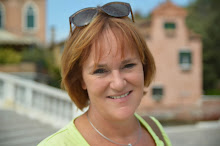See the moon shining through the trees... and in the moonlight everything looks blue.
You need:
- white drawing sheet
- oil pastel
- blue ink
- brush
- dish with water
- scouring pad
What should you do?
- Scetch a winter tree, so a tree without no leaves. Be sure your branches are thinner at the end.
- Scetch a moon between the branches.
- Draw an owl on one of those branches.
- Color the tree with blue oil pastel. Make differences in color by pressing harder or softer, or by using a little black or white.
- Color the owl blue too. Use yellow or orange for eyes and beak.
- Color the moon. It is white-yellow in the center and becomes darker yellow at the outside.
- Outline everything (even the smallest branches!) with white oil pastel. This is a difficult chore, because you barely see the white and you run the risk that the white crayon will get blue (scrape it then!).
- Paint the background will be with blue ink, water and a scouring pad. The white lines will resist the ink. Put undiluted blue ink on a dish and dip the soft side of a scouring pad in it. Stamp with along the outer edges of the drawing.
- Add water to the ink when you're nearer at the moon to make the blue lighter. Make a great light blue circle around the moon.




.jpg)


.jpg)
.jpg)





.jpg)
.jpg)


.jpg)

.jpg)





.jpg)
.jpg)
.jpg)






















